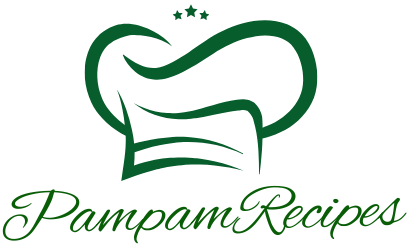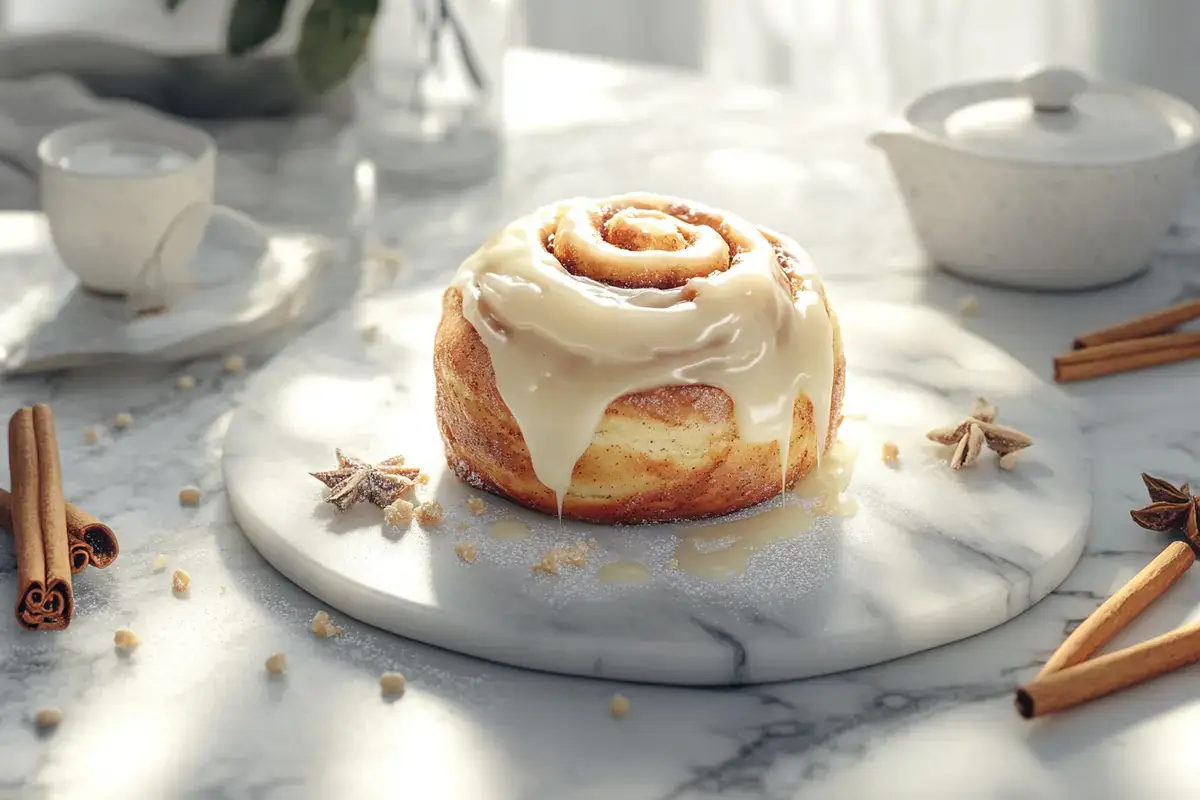introduction
Warm, gooey, and infused with the delightful aroma of cinnamon—cinnamon buns and cinnamon rolls are irresistible treats loved by many. Yet, these sweet pastries often leave people scratching their heads, wondering, “What is the difference between cinnamon bun and cinnamon roll?” While they share similarities, each has distinct qualities that set them apart.
In this article, we’ll explore their fascinating origins, key ingredient differences, and how they’re made. Additionally, we’ll provide a detailed recipe so you can recreate these delicious pastries at home. Whether you’re a baker or a curious foodie, this guide will satisfy your cravings for answers (and maybe a cinnamon treat too).
Origins of Cinnamon Buns and Roll
The European Roots of Cinnamon Rolls
Cinnamon rolls trace their origins back to Sweden and Denmark, where they are known as kanelbulle or kanelsnegle. These pastries became popular in the 17th century when cinnamon was introduced to Europe. Traditionally, they feature soft, fluffy dough rolled with butter and cinnamon, creating the iconic spiral shape.
The world fell in love with these pastries, spreading the recipe globally. Today, cinnamon rolls are a staple in bakeries, offering a simple yet indulgent treat topped with icing or frosting.
How Cinnamon Buns Evolved in Germany
Cinnamon buns, on the other hand, have their roots in Germany. While similar in appearance, buns often feature a harder sugar glaze baked directly onto the surface. Unlike rolls, cinnamon buns frequently include nuts like pecans or walnuts, adding a crunchy texture to complement the soft pastry.
German immigrants introduced cinnamon buns to North America in the 17th and 18th centuries. Over time, regional preferences led to distinct variations, such as the spicier, nut-filled buns in Canada compared to the sweeter, frosted rolls popular in the United States.
These rich histories highlight how cultural influences have shaped these beloved pastries, making them staples worldwide.
Comparing Ingredients and Preparation
Key Differences in Ingredients
When asking, “What is the difference between cinnamon bun and cinnamon roll?”, the ingredients offer significant clues. Both pastries share a base of flour, sugar, butter, and cinnamon, but they diverge in their unique additions:
- Cinnamon Rolls: These are often topped with a creamy, sweet icing or frosting. They prioritize softness, with a gooey cinnamon-sugar filling for that melt-in-your-mouth texture.
- Cinnamon Buns: Known for their sugary, slightly sticky glaze, buns often include chopped nuts or raisins baked into the dough. This creates a crunchy, textured experience.
The toppings also set them apart—rolls rely on frosting to add sweetness, while buns use caramelized sugars or honey-based glazes for their signature shine.
Baking Techniques for Buns vs. Rolls
Beyond ingredients, how these pastries are prepared also highlights their differences:
- Cinnamon Rolls: After being rolled and cut into spirals, they are baked in a tray, allowing the dough to rise and the rolls to become fluffy.
- Cinnamon Buns: Buns are baked in a pan with their glaze, which caramelizes during the process, creating a glossy finish. The addition of nuts or spices makes each bite more dynamic.
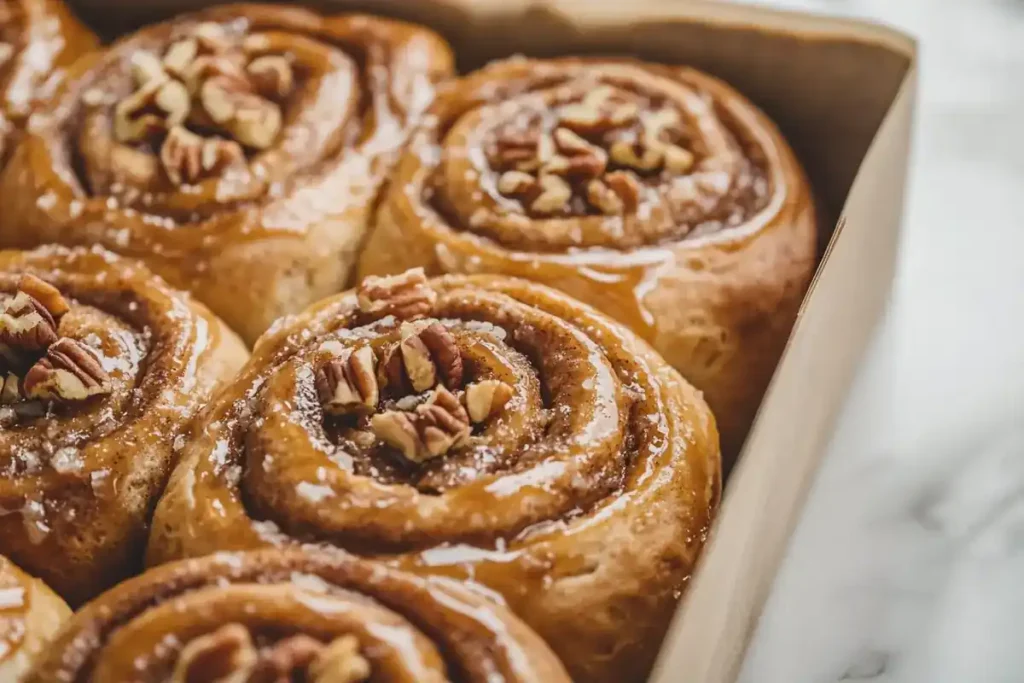
For a deeper look at baking cinnamon treats, you can explore Does Cracker Barrel French Toast Have Cinnamon?
Recipe for Homemade Cinnamon Rolls and Buns
Ingredients List for Cinnamon Rolls
To make fluffy, gooey cinnamon rolls, gather these ingredients:
- 3 ½ cups all-purpose flour
- 1 packet active dry yeast (2 ¼ tsp)
- ½ cup granulated sugar
- 1 tsp salt
- 1 cup warm milk (110°F)
- 2 large eggs
- 6 tbsp unsalted butter (softened)
- 2 tbsp ground cinnamon
For the Frosting:
- 1 cup powdered sugar
- 3 tbsp milk
- 1 tsp vanilla extract
Ingredients List for Cinnamon Buns
For nutty, caramelized cinnamon buns, you’ll need:
- 3 ½ cups all-purpose flour
- 1 packet active dry yeast (2 ¼ tsp)
- ½ cup brown sugar
- 1 tsp salt
- ¾ cup warm milk (110°F)
- 1 large egg
- 6 tbsp unsalted butter (softened)
- 2 tbsp ground cinnamon
- ½ cup chopped pecans or walnuts
For the Glaze:
- ½ cup brown sugar
- ¼ cup unsalted butter
- 2 tbsp honey
Step-by-Step Instructions
For Cinnamon Rolls:
- Prepare the Dough: Mix flour, yeast, sugar, and salt in a bowl. Add warm milk, eggs, and butter, kneading into a soft dough. Let it rise for 1 hour.
- Shape the Rolls: Roll the dough into a rectangle, spread with butter, and sprinkle with cinnamon sugar. Roll it up tightly and cut into even slices.
- Bake: Arrange slices in a greased pan and bake at 375°F for 20–25 minutes. Top with frosting once cooled.
For Cinnamon Buns:
- Prepare the Dough: Follow the same steps as above but replace granulated sugar with brown sugar.
- Add Glaze: Spread glaze on the bottom of the baking dish before adding dough slices. Include nuts if desired.
- Bake: Bake at 375°F for 25–30 minutes until the glaze caramelizes.
Nutritional Content (Per 100g)
| Nutrient | Cinnamon Rolls | Cinnamon Buns |
|---|---|---|
| Calories | 290 | 320 |
| Carbohydrates | 40g | 42g |
| Protein | 4g | 5g |
| Fat | 11g | 14g |
| Sodium | 200mg | 250mg |
Cultural Differences and Regional Preferences
Cinnamon Rolls in the United States
In the U.S., cinnamon rolls are not only a breakfast favorite but also a sweet treat enjoyed throughout the day. They are characterized by their fluffy texture, which pairs perfectly with the heavy use of frosting or glaze. Moreover, in many regions, they have become a staple in diners and bakeries. Additionally, some variations even include extra fillings, such as cream cheese or chocolate, making them even more indulgent.
The popularity of cinnamon rolls has also led to creative recipes like pumpkin spice cinnamon rolls and cinnamon roll French toast. For more creative spins, check out this pumpkin pie cinnamon rolls recipe.
Cinnamon Buns in Canada and Europe
Cinnamon buns take a slightly different route in Canada and parts of Europe. They are typically less sweet than their American counterparts and often feature spiced nuts or raisins. In Scandinavian countries, for example, cinnamon buns (like Sweden’s kanelbullar) have cardamom as an added flavor, giving them a unique taste.
Canada also has its own variation, known for a sticky caramelized glaze and a nutty crunch. These buns are more likely to be enjoyed with tea or coffee, making them a versatile snack or dessert.
These cultural differences highlight how regional preferences shape the flavor, texture, and presentation of these beloved pastries.
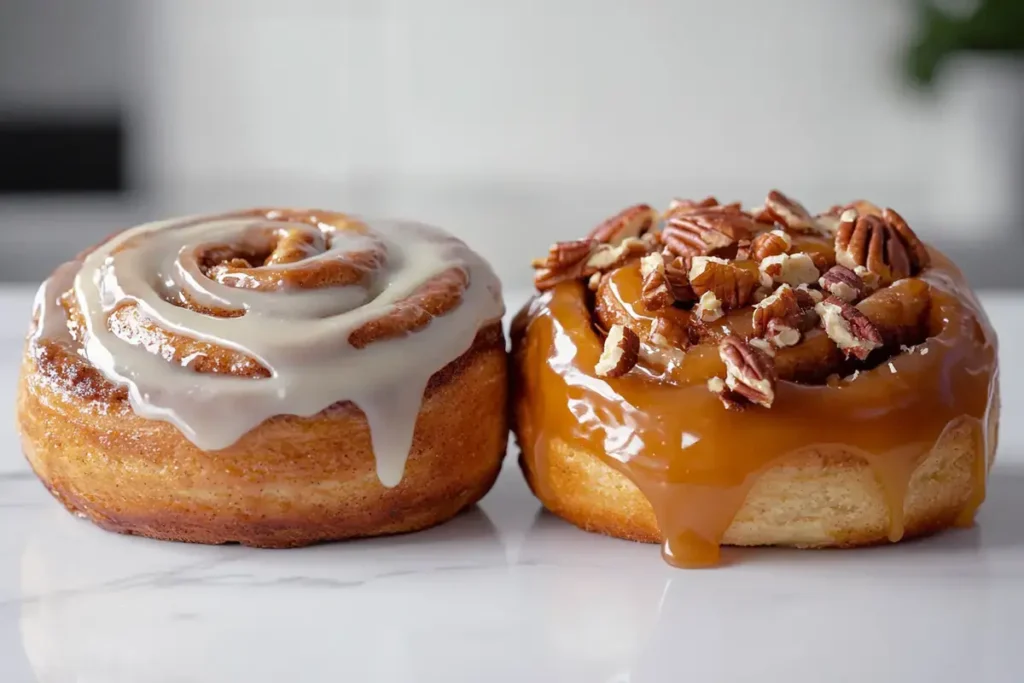
FAQs About Cinnamon Buns and Rolls
What Is the Difference Between a Roll and a Bun?
This question is at the heart of the debate. So, what is the difference between cinnamon bun and cinnamon roll? The key lies in their preparation:
- Cinnamon Rolls: Topped with icing, focusing on softness and gooey centers.
- Cinnamon Buns: Glazed with caramelized sugar and often include nuts, offering a slightly denser texture.
What’s the Difference Between a Cinnamon Roll and a Morning Bun?
While cinnamon rolls and morning buns may look similar, morning buns are made with a croissant-like dough, making them flakier. Additionally, morning buns often have citrus or vanilla notes instead of the rich cinnamon flavor found in rolls.
What Do British People Call Cinnamon Rolls?
In the UK, cinnamon rolls are sometimes referred to as cinnamon whirls or Chelsea buns, though they may have slight differences in shape and toppings. British versions are typically less sweet than the American style.
What Is Another Name for a Cinnamon Bun?
Cinnamon buns go by several names depending on the region, including:
- Sticky buns (U.S.)
- Kanelbullar (Sweden)
- Chelsea buns (UK)
These FAQs shed light on how naming and preparation styles vary worldwide, emphasizing the versatility and universal appeal of these treats.
Tips for Customizing Your Cinnamon Treats
Adding Flavors to Cinnamon Rolls
Cinnamon rolls are already a classic, but a few tweaks can make them even better. If you’ve ever asked, “What is the difference between cinnamon bun and cinnamon roll?”, one key factor is how rolls are often softer and more versatile for customization. Here are some ideas:
- Orange Zest: Add a teaspoon of orange zest to the filling for a citrusy twist.
- Cardamom: A pinch of cardamom in the dough or filling gives a hint of spice, reminiscent of Swedish recipes.
- Vanilla Glaze: Enhance the icing with a splash of vanilla extract for a deeper flavor.
- Chocolate Filling: Replace the cinnamon-sugar mix with cocoa powder and brown sugar for a decadent treat.
These simple changes allow you to experiment with flavors while maintaining the roll’s signature softness.
Enhancing Cinnamon Buns with Toppings
Cinnamon buns, with their firmer structure and caramelized glaze, are perfect for additional toppings. Here’s how you can elevate them:
- Candied Nuts: Sprinkle chopped candied pecans or walnuts on top before baking for extra crunch.
- Caramel Drizzle: After baking, add a light drizzle of caramel sauce for a sweeter finish.
- Spices: Mix nutmeg or allspice into the glaze for a warm, spiced flavor.
- Raisins or Dried Fruit: Incorporate these into the dough or sprinkle on top for added texture.
Whether you prefer the soft richness of cinnamon rolls or the textured sweetness of cinnamon buns, these ideas will take your baking to the next level.
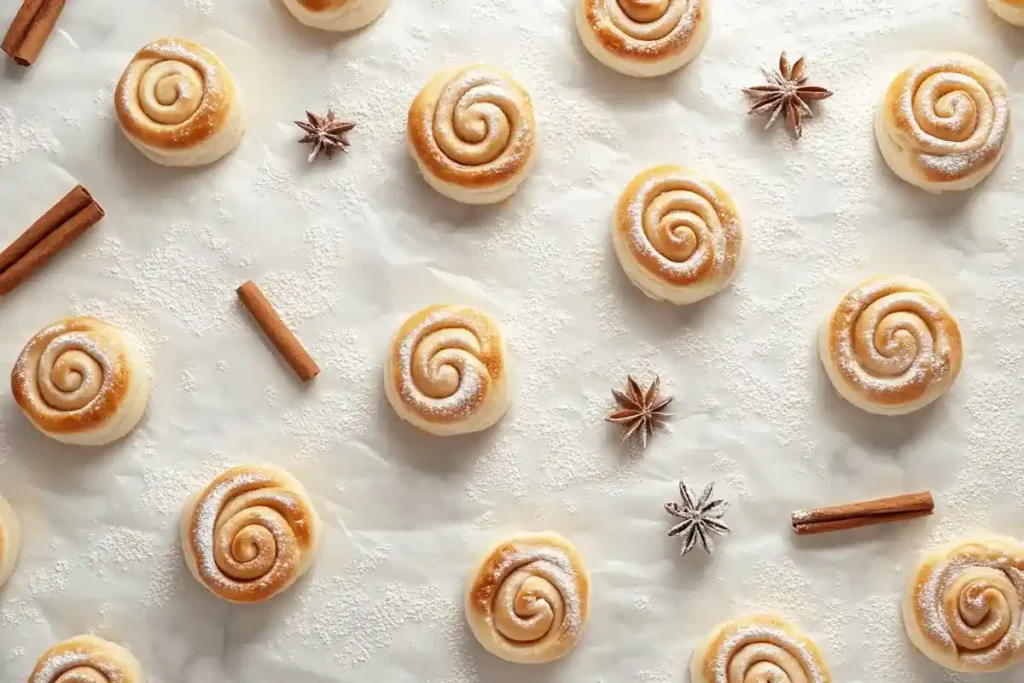
Cinnamon Bun and Roll Storage and Reheating
Best Practices for Keeping Them Fresh
To enjoy your cinnamon rolls or buns at their best, proper storage is essential. Depending on whether you’ve baked them fresh or have leftovers, follow these tips:
- Cool Before Storing: Always let the pastries cool completely before storing to avoid condensation, which can make them soggy.
- Airtight Containers: Place them in an airtight container to lock in moisture. For buns, store the glaze separately to keep the texture intact.
- Refrigeration and Freezing:
- Refrigerator: Store for up to 3 days. Reheat before serving for optimal softness.
- Freezer: Wrap each roll or bun individually in plastic wrap, then place in a freezer-safe bag for up to 2 months.
Reheating for Maximum Freshness
Reheating correctly ensures your cinnamon buns or rolls taste just as good as when they were freshly baked.
- Oven Method: Preheat the oven to 350°F (175°C). Place the rolls or buns on a baking sheet, cover with foil, and heat for 10–15 minutes. This method preserves their soft, gooey centers.
- Microwave Method: Heat individual rolls or buns for 15–20 seconds, but be cautious, as they can dry out quickly.
- Air Fryer Method: For a slightly crisp exterior, reheat in the air fryer at 325°F (160°C) for 4–5 minutes.
Whether you’re savoring them immediately or storing them for later, these tips ensure your cinnamon treats remain delicious and satisfying.
Why Cinnamon Buns and Rolls Are Universal Favorites
The Appeal of Cinnamon Buns
Cinnamon buns are cherished worldwide for their unique combination of flavors and textures. Not only does their caramelized glaze create a delightful sweetness, but it’s also often paired with nuts or dried fruit, adding even more complexity to every bite. If you’re wondering, “What is the difference between cinnamon bun and cinnamon roll?”, it’s important to note that buns stand out because of their slightly firmer texture and rich topping.
Cinnamon buns also adapt beautifully to different cultural preferences. In Canada, they’re a common bakery item, enjoyed with coffee or tea, while in Europe, they lean toward less sweetness with spiced notes like cardamom. Their versatility makes them a timeless pastry, loved by many.
The Popularity of Cinnamon Rolls
Cinnamon rolls, on the other hand, offer a softer and sweeter experience. Their gooey center, paired with a creamy frosting, is what makes them irresistible. Whether served as a breakfast staple or a dessert, rolls have a comforting familiarity that appeals to all age groups.
What sets cinnamon rolls apart is their adaptability. You’ll find creative versions like pumpkin spice rolls, chocolate-stuffed rolls, and even savory variations. This adaptability, combined with their simplicity, explains why cinnamon rolls have such universal appeal.
Final Thoughts
Choosing Your Favorite
So, what is the difference between cinnamon bun and cinnamon roll? While they share a common love for cinnamon, their differences lie in texture, toppings, and preparation. Rolls prioritize softness and gooey sweetness, while buns deliver a firmer bite with added crunch and caramelized glaze.
Key Takeaways
- Cinnamon Rolls: Ideal for those who love soft, fluffy pastries topped with sweet icing.
- Cinnamon Buns: Perfect for anyone craving a nutty, caramelized treat with a bit of texture.
No matter your choice, both are versatile enough to enjoy at breakfast, dessert, or as a comforting snack. Experiment with toppings and fillings to make these pastries your own.
For more baking inspiration, explore PamPam Recipes, where you’ll find creative twists on classic pastries like cinnamon rolls and buns. With this guide, you’re ready to bake, customize, and savor the differences between these beloved treats!
